Building Your Ideal Wardrobe: A Complete Guide
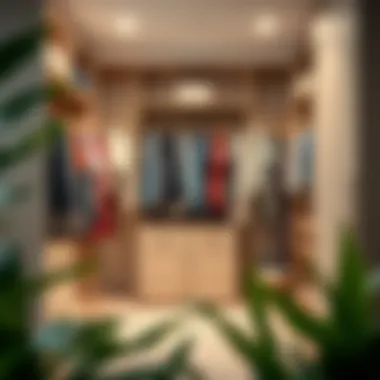
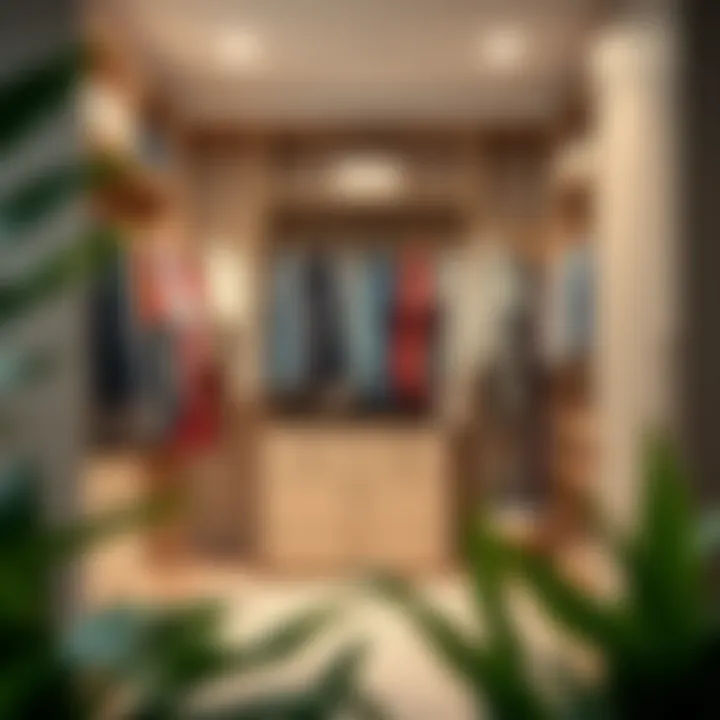
Intro
Creating a personal wardrobe can feel like standing at the edge of an immense ocean, with waves of fashion trends crashing around you. The key is not just to keep your head above water, but to explore those waters with a sense of purpose and style. What one wears is an extension of themselves, a tapestry woven from experiences, values, and even aspirations.
When embarking on this journey, consider it as not merely filling your closet but curating a collection that resonates with who you are. This involves understanding your own aesthetic and functional needs—what speaks to you, what serves your lifestyle, and what might become a cherished piece in your collection.
In this article, you will navigate through various aspects of wardrobe building. From the initial planning stages to practical strategies for selection, every detail contributes to a well-rounded wardrobe. Recognizing the interplay of aesthetics and functionality is crucial, as your clothing must adapt to diverse scenarios, whether it’s a day at work, a casual outing, or an elegant event.
If you’re ready, let’s dive into the first section, engaging with the foundational elements that will shape your wardrobe's character.
Understanding Personal Style
In the realm of personal fashion, understanding your style is akin to laying the cornerstone of a beautiful house. It’s the foundation on which everything else rests. Knowing your unique sense of style not only helps you curate a wardrobe that reflects your identity, but also ensures that your clothing meets your lifestyle needs while showcasing your personality.
When you have a clear grasp of your personal style, shopping becomes less of a chore and more of an art. Say goodbye to impulse buys that collect dust at the back of the closet! Instead, each piece you bring home can serve a distinct purpose, enhancing both your confidence and your comfort.
Defining Your Aesthetic
Taking the time to define your aesthetic may feel like a daunting task, but breaking it down can simplify the process significantly. Consider what styles resonate with you. Are you drawn to sleek, modern silhouettes or perhaps you fancy a more vintage touch? One effective way to pinpoint your aesthetic is through visual inspiration; look at fashion magazines, Instagram feeds, or even mood boards on Pinterest.
As you explore your preferences, jot down themes that emerge. You might find you lean towards a bohemian vibe—flowy fabrics and earthy colors—or you might appreciate the sophistication of minimalism and clean lines. The clearer you are about what you like, the more informed your purchases will be.
Assessing Your Lifestyle Needs
Your wardrobe should work for you, not the other way around. Start by taking a good look at your daily routines. Are you a stay-at-home parent, a corporate professional, or an outdoor enthusiast? Each lifestyle presents different clothing demands. Write down a typical week in your life, and think about the environments you navigate through.
- If you attend professional meetings regularly, investing in tailored pieces such as blazers and dress pants is crucial.
- For those who thrive in casual, laid-back settings, soft tees and breathable fabrics might be more appropriate.
- Active lifestyles may call for functional outfits that prioritize comfort and durability, like athleisure wear.
Identifying Influencers and Inspirations
We’re all products of our environments; fashion influencers, friends, or even celebrities can have a profound impact on our style choices. Pay attention to what catches your eye when scrolling through social media or gazing at editorial spreads. What are the common threads? Notice how certain colors or silhouettes resonate with you.
Engage with the fashion community as well; explore platforms like Reddit for discussions on styles you admire or visit blogs that align with your aesthetic interests. Recognizing who influences your style can help refine your wardrobe selection and ensure you are always authentic to your true self.
"Style is a way to say who you are without having to speak." – Rachel Zoe
Evaluating Current Wardrobe
To embark on the journey of crafting a personal wardrobe, evaluating what’s already in your closet is crucial. This step helps in discerning what you truly need versus what you've acquired over time. Not only does it foster a sense of clarity, but it also paves the way for intentional selections moving forward. The task of evaluating can reveal hidden treasures, but also excess baggage you might have overlooked. Therefore, understanding the nuances of your current wardrobe sets the stage for informed decisions and enhancements.
Inventory Your Clothing
Taking stock of what you've got is the first step in this evaluative dance. An inventory brings everything into clear sight and highlights where the gaps lie. Organizing garments offers a shortcut to clarity and can even rekindle your love for fashion.
Categorizing by Type
One of the most effective methods to organize your clothing is through categorizing by type. Think about separating items into groups such as tops, bottoms, outwear, and special occasion wear. This categorization serves a dual purpose: it boosts efficiency when you’re dressing in the morning and also highlights redundancy in your collection.
A hallmark characteristic of this method is ease of access. No more rummaging through jumbled piles, everything is at your fingertips with a clear view of each type. Also, it's easy to notice if there’s an imbalance in your collection; maybe you have a dozen graphic tees but are left high and dry when it comes to formal blouses. That imbalance can steer future shopping trips in a productive direction, making it a smart strategy.
However, the downside of this approach might be that it can feel a bit tedious, especially if your wardrobe is bloated. Tackling everything at once can be overwhelming, so break it down into bite-sized pieces.
Noting Frequently Worn Items
Equally important is the practice of noting frequently worn items. As you sift through your collection, make a conscious effort to highlight pieces that make regular appearances in your outfits. This practice helps in discerning which items resonate with your personal style and lifestyle needs.
The key characteristic of this step is its focus on actual usage rather than sentimental attachment. Knowing what you wear regularly can aid in shedding items that no longer serve a purpose. You might find that certain clothes hang around simply because you bought them on a whim but never actually wore them. Instead of taking up space, these items could easily be donated or sold.
The unique feature of noting frequently worn items is that it fosters a sense of authenticity in your wardrobe. With a clearer picture of the clothes that you truly love, the danger of impulse buying lessens. A wardrobe enriched with pieces that fit your day-to-day life is both functional and satisfying. However, it’s important to approach this process with an open mind; sometimes, people mistakenly categorize items as favorites when they are mostly worn out or mismatched.
Identifying Gaps and Surpluses
Once the inventory process is done, it’s time to identify gaps and surpluses. Evaluating your wardrobe should culminate in a clear understanding of the fitting pieces required versus those that have overstayed their welcome.
Gaps are those spaces where essential pieces are conspicuously absent. For instance, perhaps your wardrobe lacks a reliable pair of black formal trousers, or you need a decent rain jacket as the weather flops in and out. This insight not only spotlights what’s needed but also streamlines future purchases, ensuring that you invest in essentials that complement rather than clutter.
Alternatively, surpluses could reveal the quantity of similar items you possess. Picture a wardrobe brimming with four nearly identical denim jackets. This overabundance might indicate a tendency to replicate styles, which can restrict exploration into other types of clothing or trends.
In essence, evaluating your current wardrobe isn't just about decluttering. It’s a measures for crafting an intentional wardrobe that truly reflects who you are and suits your needs. Take the time to refine your collection, approach it thoughtfully, and you'll lay down a solid foundation for everything that comes next.
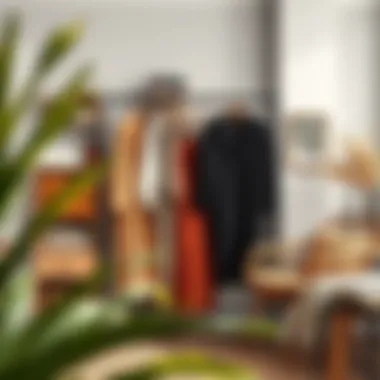
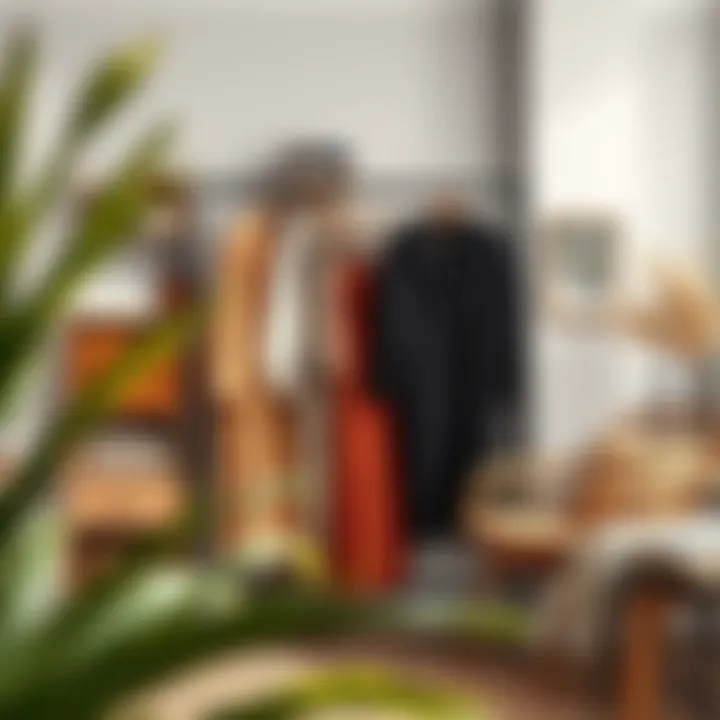
Setting a Budget
Setting a budget is an essential step in creating a personal wardrobe that reflects your style and meets your practical needs. Without a clear financial plan, it’s easy to get swept away by the allure of trendy pieces and impulsive buys. This section aims to shed light on the importance of budgeting in wardrobe curation, alongside specific strategies that can help you allocate your resources wisely.
Determining Monthly Allocation
To begin with, determining your monthly allocation is crucial. It’s helpful to sit down and take a good long look at your finances. Begin by identifying your income and then itemizing your expenses. Remember, clothing is just one slice of the financial pie. Carve out a portion that realistically reflects what you can spend on clothing while still being able to live comfortably.
- Start with a small trial period, like three months. This will let you gauge your spending habits.
- Categorize essentials and luxuries. Essentials might include basic clothing, while luxuries could be higher-end items or trendy additions.
- Keep track of your spending. Apps and spreadsheets can come in handy for monitoring how much you allocate each month.
Once you've got a handle on what you can afford to spend each month, you’ll find it easier to make informed decisions on purchases. Have a set figure, but also build in a little flexibility for those unanticipated finds. After all, sometimes that unique piece just jumps out at you and commands attention!
Prioritizing Quality Over Quantity
When you don’t have limitless resources, quality can often take a backseat to quantity, but it shouldn't – it’s the tortoise and the hare of the wardrobe world. Prioritizing quality means investing in clothing that lasts longer and looks better over time. Let’s break down a few vital considerations on why this matters.
- Longevity: High-quality items tend to endure wear and tear better than their cheaper counterparts. A well-made coat can last a decade while a fast fashion piece may only see a handful of seasons before it wears out.
- Versatility: Quality garments often have a timeless design that allows for easy mixing and matching. This versatility increases your wardrobe’s overall functionality.
- Cost-effectiveness: Though the initial cost may be higher, spending money on fewer, quality items can be more economically sound in the long run. Instead of frequently replacing items, a few good pieces can serve you well through multiple seasons.
It’s worth remembering that you can find quality without necessarily breaking the bank. Look for sales, or consider secondhand options that provide excellent quality at a more reasonable price. With a well-planned budget and a focus on quality, you can curate a wardrobe that not only looks great but enhances your overall lifestyle.
"A budget is telling your money where to go instead of wondering where it went."
This mindset will empower you to make style choices that align with your identity while also keeping your finances in check.
Curating Essentials
Curating essentials is a pivotal part of crafting a personal wardrobe. Essentials serve as the backbone of your closet, ensuring that you have the necessary items to mix and match for various occasions. When you take the time to carefully select these cornerstone pieces, you create a flexible base from which you can express your style. Think of these essentials as the trusty tools in a toolkit. Without them, your wardrobe can quickly become chaotic, lacking direction and coherence.
Staple Pieces Required
Tops
Tops represent a crucial element in any wardrobe. They can transform an outfit from plain to striking with the right choice. A well-fitted shirt or a comfortable tee can elevate your look without breaking a sweat. Essential tops should combine versatility and comfort, making them easy to wear across different settings, whether at the office or out on the town.
One of the key characteristics of tops is their variety — from casual t-shirts to elegant blouses. This versatility allows for seamless transitions between various social settings. Unique feature of tops is that some can be layered, making them even more practical in different seasons. A disadvantage, however, can be the challenge of maintaining them; tops can fade over time or lose their shape if not cared for properly.
Bottoms
Bottoms provide structure to your outfits and are equally vital for any wardrobe. Think about the type of bottoms you often reach for: are they jeans, trousers, or maybe skirts? This choice greatly impacts your overall style and function. A reliable pair of jeans is fantastic for casual outings but may not suffice for more formal events.
The key characteristic of bottoms lies in their foundational role. They provide balance when paired with various tops, ensuring your outfit remains cohesive. The unique features of bottoms can include different cuts and materials, allowing for options that are both comfortable and stylish. However, finding the right fit can sometimes be a hit-or-miss, which could lead to frustration and lost time.
Outerwear
Outerwear serves as the finishing touch, especially during colder months. A well-chosen jacket or coat can indeed pull your entire look together while keeping you warm. Outerwear is important, as it can protect you from the elements while making a statement about your fashion sense.
The primary characteristic of outerwear is its functionality; it is often the first layer someone notices. High-quality outerwear typically lasts for years, which adds to its value. A unique feature is its ability to be layered over various outfits, adding an additional dimension to your style. Nevertheless, outerwear can sometimes be bulky or heavy, which is crucial to consider when selecting pieces suited to your lifestyle.
Versatile Accessories
Shoes
Shoes can either make or break an outfit. A solid pair of versatile shoes can take you from the boardroom to casual gatherings without missing a beat. Their importance cannot be overstated, as they ground your ensemble.
Key characteristics of good shoes are comfort and adaptability. A pair of stylish loafers can be dressed up or down, making them a staple. One unique feature is the wide variety available — from heels to flats, there’s something for every occasion. However, it’s essential to choose wisely, as poorly made shoes can lead to discomfort and even long-term foot issues.
Bags
Bags serve not only as practical carriers but also as significant fashion statements. The choice of a bag can reflect your personal style just as much as your clothes do. In terms of importance, having a few go-to bags for different purposes can simplify your daily routine immensely.
The top characteristic of bags, especially a classic tote, is their spaciousness and ease of access. They meld well into any style, whether you’re going for chic or casual. A unique feature is the range of materials and styles available, which means there’s always a new bag trend to explore. However, quality can be an issue, as cheaper bags can wear out quickly, losing both shape and functionality.
Jewelry
Jewelry plays a delicate yet impactful role in personal style. The right pieces can accentuate your outfit, providing that extra flair that ties everything together. Jewelry's contribution to your wardrobe includes adding a personalized touch, reflecting your individual tastes and preferences.
A key characteristic of jewelry, particularly statement pieces, is their ability to draw attention. An elegant pendant or a bold bracelet can become conversation starters. Unique features include the variety of styles available, from minimalist to extravagant. However, many individuals may find themselves overwhelmed with choices, which could lead to inconsistent selections.
In summary, curating essentials in your wardrobe serves as the foundation for your personal style, making life simpler while enhancing your fashion identity.
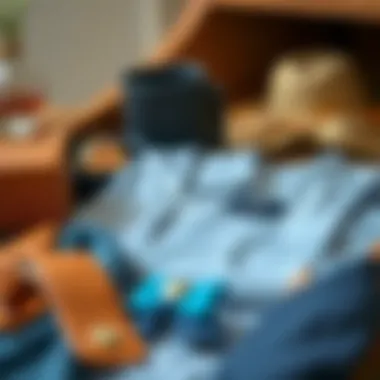
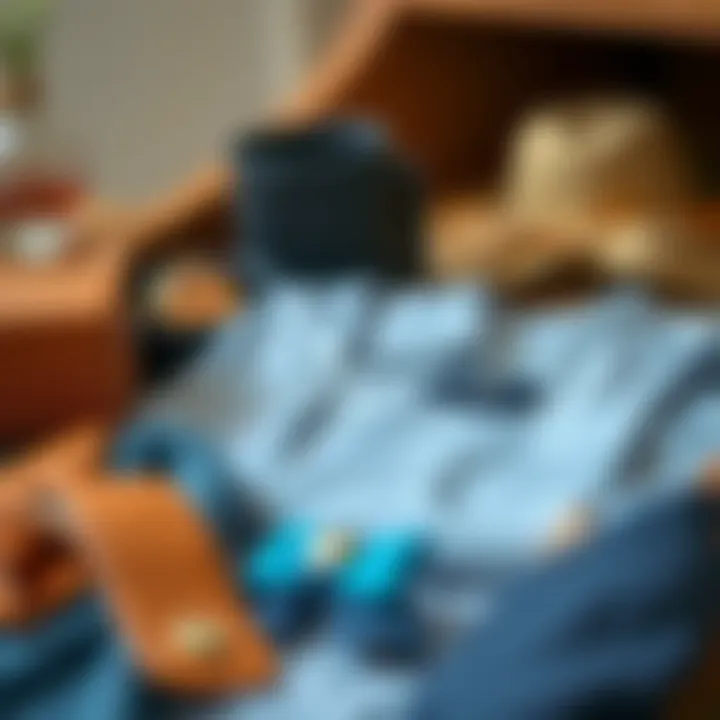
Sustainable and Ethical Choices
Creating a wardrobe that reflects not only personal style but also responsible choices can be a transformative journey. Sustainable and ethical choices play a crucial role in this process, significantly impacting both the environment and communities. As fashion becomes more accessible, the fast-paced nature of trends can often lead to waste and exploitation of resources. However, making informed decisions about what to wear is vital, not just for personal identity but for the broader impact it has on our world.
Choosing sustainable materials and supporting ethical brands ensures that each piece in your wardrobe isn’t just a reflection of your aesthetic preferences but also a statement of values.
Understanding Sustainable Fabrics
The fabric of your clothing is where sustainability begins. The use of sustainable fabrics can help reduce environmental footprints, employing methods that are kinder to the planet. Here are some materials worth considering:
- Organic Cotton: Unlike conventional cotton, this is grown without harmful pesticides or fertilizers, which reduces soil and water pollution.
- Tencel (Lyocell): This fiber is made from the pulp of eucalyptus trees. The production process recycles water and uses non-toxic solvents, making it a fantastic eco-friendly choice.
- Recycled Polyester: Often made from post-consumer plastic bottles, this fabric turns waste into new clothing, reducing plastic in landfills.
- Hemp: A robust plant that requires minimal water and no pesticides, hemp is a sustainable powerhouse in fabric production, contributing to soil health as it grows.
Selecting clothing made from these materials not only supports sustainable practices but also often results in higher quality garments that last longer in your wardrobe. This longevity contributes to a more responsible consumption pattern, minimizing waste over time.
Supporting Ethical Brands
Shifting towards brands with ethical practices is paramount when it comes to reshaping your wardrobe. Ethically produced clothing is rooted in fair labor practices, safe working conditions, and reasonable wages. Here are reasons to consider:
- Transparency: Ethical brands typically offer insight into their supply chains, which builds trust and allows you to make informed choices.
- Community Support: Many ethical brands prioritize local production and support artisans and craftspeople in their communities, promoting economic empowerment.
- Environmentally Friendly Practices: Look for brands that utilize eco-friendly manufacturing processes and sustainable materials. This ensures a reduced impact on both community and environment.
Supporting these brands doesn’t just change your wardrobe; it alters the landscape of fashion. Even small purchases can drive a demand for better practices and inspire larger brands to reconsider their production methods.
"Fashion is transient, but values are permanent. By carefully choosing where we spend our money, we can champion a movement toward sustainability."
In summary, incorporating sustainable fabrics and aligning with ethical brands transforms your wardrobe into a compassionate collection that resonates with the values you represent. Making these choices enriches not only your personal style but also promotes a fashion landscape that priorities the well-being of people and the planet. In the long run, this conscientious approach to fashion strengthens consumer voice, encouraging others to follow suit and reconsider their purchasing practices.
Seasonal Adaptation
The way we dress should change with the seasons, reflecting not just our style but also the environment we live in. Seasonal adaptation is key to curating a versatile wardrobe that is responsive to weather changes while also maximizing comfort and aesthetics on seasonal shifts. In short, it’s about making sure your closet works for you the entire year, not just during the sunny days of summer or those chilly winter evenings.
Adapting Wardrobe for Weather Changes
Fashion is not solely about looking good; it’s also rooted in practicality. Weather changes demand different clothing choices that cater to both function and flair. Consider this: when temperatures dip, you wouldn’t show up in your favourite short-sleeved shirt and shorts. Instead, it's essential to have a fundamental understanding of how to adapt your wardrobe accordingly. Here are a few ways to do this:
- Layer Up: Layering is not just a fashion statement but a practical approach. Think thermal tops or turtlenecks under sweaters. This adds warmth without compromising style.
- Material Matters: When it comes to changing seasons, fabrics play a significant role. Transition from breathable cottons in summer to cozy wool or cashmere in fall. Investing in high-quality fabrics will not only keep you comfortable but also elevate your overall appearance.
- Accessorize Thoughtfully: Seasonal accessories can transform an outfit. In winter, think about scarves, gloves, and hats made of warm fabrics. During summer, switch to light fabrics and refreshing patterns. They help bridge the gap between comfort and style while ensuring you're equipped for temperature fluctuations.
Layering Techniques
Mastering the art of layering can be a game changer when crafting a personalized wardrobe. It allows you to play with different textures and styles while ensuring suitable warmth and comfort throughout the day. When layering, consider:
- Base Layer: Start with a snug-fit base layer. This could be a high-quality tank top or a fitted long-sleeve shirt that acts as your foundation. The right base layer makes a world of difference, keeping you cozy while serving as the foundation for your outfit.
- Middle Layer: Next, add a middle layer for insulation. This could be anything from a light cardigan to a thicker pullover, depending on the chill factor. Remember, the middle layer should compliment your base layer in both color and texture.
- Outermost Layer: Finally, your outer layer should protect you from the elements. This could be a stylish trench coat, a warm parka, or a chic blazer depending on the occasion and weather.
Key Insight: The best part about layering is versatility—you can easily add or remove layers as the day progresses. Not to mention, it enhances the visual appeal of your outfits by creating depth and interest.
In summary, handling seasonal changes effectively transforms your wardrobe from an occasional collection to a truly functional and reflective extension of your personal style. It helps you navigate through the complexities of both fashion choices and changing temperatures, ensuring that you look and feel your best all year round.
Personalization through Tailoring
When it comes to crafting a wardrobe that truly reflects your unique style, personalization stands out as a vital element. Tailoring, in particular, transforms generic pieces into something that feels intentional and fitted specifically for you. Not only does tailored clothing elevate your confidence, but it can also enhance the overall aesthetics of your wardrobe. In a world where fast fashion dominates, taking time to refine fit through tailoring can make your clothing collection feel infinitely more sophisticated and individualized.
The Importance of Fit
The concept of fit cannot be overstated. A well-fitted garment has the power to elevate your outfit, making you appear more polished without needing to wear designer labels. When a piece is tailored to your dimensions, it drapes in a way that complements your body shape, rather than altering your silhouette to meet mass-market standards. Here are some key benefits of focusing on fit:
- Enhanced Silhouette: Proper fit highlights your best features while minimizing areas you might wish to downplay.
- Increased Comfort: Ill-fitting clothes can feel restrictive or too loose and baggy, making you constantly adjust throughout the day. Tailored pieces, however, provide a level of comfort that allows for easy movement.
- Longevity: Well-constructed, tailored pieces often stand the test of time. Instead of cycling through fast fashion, these investments lead to a more sustainable closet that you'll cherish for years.
Ultimately, it's about expressing who you are through what you wear and ensuring that every piece brings out your personal style.
Finding a Good Tailor
Choosing a tailor is just as important as the tailoring itself. A good tailor understands your vision, making insightful suggestions that align with your style while enhancing the fit. Here are some effective strategies for finding someone who can truly bring your wardrobe to life:
- Research Recommendations: Start by asking friends, family, or colleagues who they trust for tailoring services. Word of mouth often leads to finding hidden gems in your area.
- Visit Local Shops: Taking a stroll through your neighborhood can yield surprising results. Visit tailors and seamstresses to get a feel for their craftsmanship and customer service.
- Review Portfolios: Many tailors may have portfolios of their previous work. Take a look at their past alterations and finished pieces to gauge their expertise.
- Start Small: If you're unsure about a tailor, begin with a minor alteration. This gives you a sense of their skill and how well they understand your preferences without making a significant commitment.
By selecting the right professional to work with, you're investing not just in clothing but in a tailored experience that enhances your overall wardrobe.
Important Note: A good tailor can make all the difference. It may take time to find the right fit—pun intended—but the effort is surely worth it in the end.
Experimenting with Trends
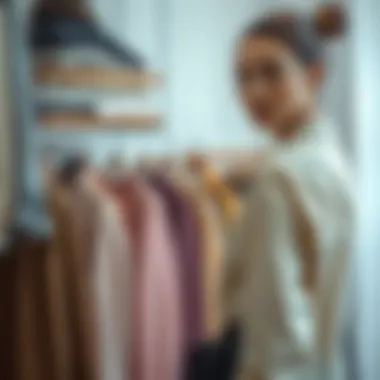
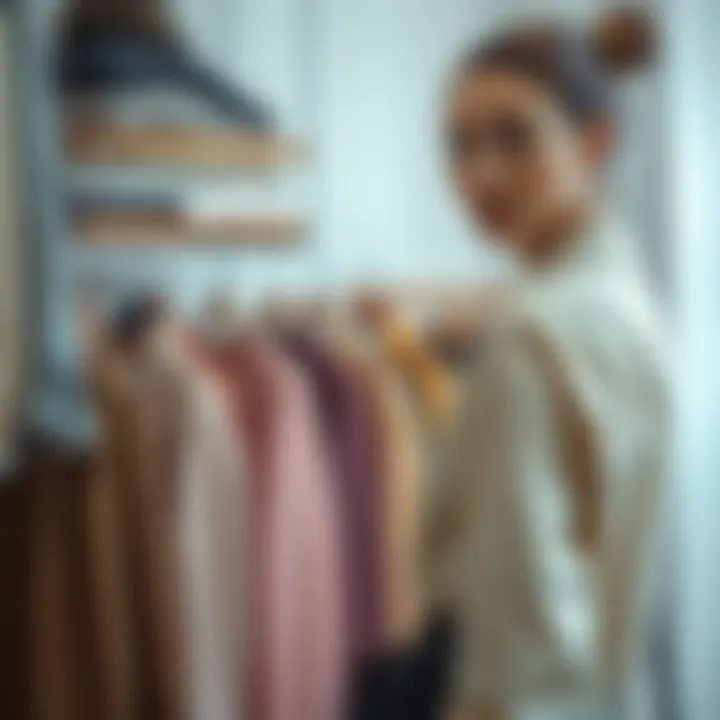
In the ever-evolving world of fashion, staying current is as crucial as understanding one’s personal style. Trends can breathe new life into a wardrobe and provide fresh avenues for self-exploration. When handled with care, experimenting with trends can lift your fashion game to new heights. However, it’s essential to approach this topic strategically, keeping in mind that not every trend will resonate with your unique aesthetic.
Incorporating Trendy Items Intelligently
Embracing trends doesn't mean turning your wardrobe into a revolving door of the latest fads. The key is to incorporate trendy pieces in a manner that complements your existing styles while still reflecting your true self. Here are several insights on doing just that:
- Identify the Trends that Speak to You: Before diving headfirst into the latest runway looks, take time to assess which trends genuinely align with your story. If you adore earthy tones, perhaps incorporating a popular color of the season would work better than adopting an entirely different style.
- Mix Old with New: New and exciting pieces can enhance what you already own. For instance, if animal print is making waves, style a trendy leopard print blouse with a classic black blazer from your wardrobe. This way, you create an outfit that feels fresh yet true to your deeper style roots.
- Accessorize Wisely: Often, the right accessory can make all the difference. Investing in a trend-inspired bag or a pair of shoes might be a more budget-friendly option than an entire wardrobe overhaul. Plus, accessories are less likely to overwhelm your existing collections.
Incorporating trend-driven items must feel effortless. It’s about adding that cherry on top rather than changing the entire cake, so aim for balance in blending the old with the new.
Knowing When to Skip Trends
Being aware of when to skip a trend is just as vital as knowing when to embrace one. Not every trend deserves a spot in your closet. The stakes can be higher than just another failed purchase; trends can often disrupt your signature look. Here’s how to gauge when to give a trend a pass:
- Listen to Your Guts: If you’re drawn to a trend but have reservations, take it slow. It might be that the trend lacks authenticity or doesn’t quite suit your lifestyle. Trusting your instincts can save you from looking like a fish out of water.
- Assess Longevity: Some trends are like fireflies—they flash brightly for a moment and then fade away. Before committing, ask yourself if this is something that will remain relevant next year. If it feels like a fleeting moment, it’s wise to keep it at arm’s length.
- Evaluate Fit and Practicality: While a trend might look fantastic on models strutting down the runway, not every style is practical for everyday wear. Clothes that require constant adjusting or attention might not serve you well in a fast-paced lifestyle.
In sum, skipping trends doesn’t make you less fashionable; it showcases discernment. As in any art form, the essence of your wardrobe should be a curated reflection of you—timeless yet contemporary.
"Style is a way to say who you are without having to speak." – Rachel Zoe
Experimenting with trends is more about adding nuance than redefining your ethos. It is a fine dance between the new and the known. Thus, proceed thoughtfully, allowing your wardrobe to tell a story that’s uniquely yours.
Maintaining Organization
A well-organized wardrobe isn’t just about neatness; it’s a game-changer for your daily routine and style expression. When your clothing pieces are organized, you save time, reduce stress, and streamline the process of getting dressed. Creating an organized space allows you to easily see what you have, make better choices, and enhance your overall fashion experience.
Storage Solutions for Efficiency
To achieve efficiency in your wardrobe, smart storage solutions play a pivotal role.
- Utilize Vertical Space: Often, people overlook vertical storage options. Use tall shelving units, hangers, or hooks to maximize space. This not only keeps items off the floor, but makes them visually accessible.
- Drawer Dividers: Consider investing in drawer dividers for items like undergarments, socks, and accessories. This little addition ensures every item has its own spot, preventing the inevitable clutter that can arise when clothes are tossed randomly.
- Vacuum Bags for Off-Season Clothing: When seasons change, it’s essential to store off-season clothing properly. Vacuum-sealed bags protect items from dust and moisture, and they save precious space in your closet.
- Clear Storage Bins: Utilizing clear bins allows you to see your stored items without opening every box. Label them clearly, so when you’re in a pinch, you can grab exactly what you need without a second thought.
"An organized wardrobe not only saves time but transforms the dressing experience into a moment of inspiration rather than a chore."
By making a few strategic storage choices, your freshly curated wardrobe becomes a personal sanctuary that encourages experimentation.
Regular Reviews and Updates
Organization isn’t a one-and-done task; it's an ongoing endeavor. Regularly reviewing and updating your wardrobe is crucial for maintaining its ordered state. Here's why it's important:
- Inventory Check: Seasonal changes or personal life shifts may influence your needs. A bi-annual review helps ensure your wardrobe reflects current lifestyle demands.
- Identifying Non-Wearables: Clothes that haven’t seen the light of day in ages likely need to find a new home. Cultivating a habit of letting go can liberate your closet from excess and make room for new favorites.
- Incorporating New Finds: As you explore fashion trends and pieces that resonate with you, ensure you have space to accommodate these additions. The best approach is to regularly reassess and make strategic choices about what stays and what goes.
A simple checklist can assist you during your review process:
- When did I last wear this?
- Does it fit well?
- Is the color still appealing?
- Does it match my current style or lifestyle?
By incorporating routine checks into your organizational practice, you maintain not just an orderly space but a wardrobe that evolves with you, enhancing both your style and comfort.
Final Considerations
As we reach the closing chapter of our exploration into wardrobe creation, it’s crucial to reflect on what we’ve discussed and to make sure it all resonates with your personal journey in fashion. Final considerations in crafting your wardrobe play a pivotal role in solidifying the understanding of what we’ve learned. This section emphasizes not just the synthesis of your choices but also how each step can serve as a stepping stone into a more defined personal style.
When considering your wardrobe, remember that style is not a static concept. It evolves as you do. By pondering over the choices you've made and the pieces you cherish, you develop a deeper connection with your fashion identity. This reflection allows you to appreciate how your aesthetic has shifted over time—whether it has moved from minimalist to bohemian or transitioned into a more professional palette. Reflecting on this journey helps you define what aspects of your style bring you joy and confidence.
Reflection on Style Evolution
Your style journey is like a narrative, one that is continually being written. It’s essential to pause and evaluate how your style has changed through different periods in your life. Perhaps your wardrobe started with bright colors and bold patterns in your twenties, later settling into a more neutral and sophisticated palette as work demands increased. This evolution is not a cause for concern, but rather a natural progression.
- Key Elements of Style Evolution:
- Age and Maturity: As one matures, tastes change.
- Lifestyle Changes: A new job, marriage, or city can significantly affect personal style.
- Trends and Influences: Exposure to different cultures or style influencers can lead to new interests.
Understanding these factors aids in framing your future wardrobe choices. It allows you to appreciate growth, pushing the narrative of your wardrobe. Always consider keeping some elements of your past for sentiment’s sake; they often serve as comfort pieces that remind us of who we once were.
Setting Future Wardrobe Goals
After reflecting on where you’ve been, it’s time to think about where you want to go. Setting specific goals for your wardrobe transforms the mere task of shopping into a purpose-driven endeavor. To help structure these goals:
- Identify Wardrobe Needs: What do you lack in your current collection? A versatile little black dress? Smart trousers for work?
- Experiment with New Styles: Dare to branch out. If you’ve been keen on a specific trend, perhaps give it a whirl.
- Aim for Quality: Commit to investing in fewer high-quality pieces that serve multiple purposes instead of fast fashion.
Future goals should work in tandem with your evolving personal style. As time goes by, reassess this list and adapt it according to your growth. Remember:
“Fashion is fleeting; style is eternal.”
This wise saying encapsulates the essence of wardrobe building. Making informed choices, based on both past reflections and future aspirations, guarantees that your wardrobe will not only be visually stunning but also deeply reflective of who you are and who you wish to become. Let's not forget the essence of curating a collection that resonates with personal identity while also meeting practical needs—this harmonious balance will help ensure that your wardrobe serves you well in all walks of life.
These final considerations help you to ground yourself in your journey. Approach each shopping venture with intention and clarity, and aim to be mindful of your unique fashion tale. By doing so, you are turning what might seem like a mundane task into an engaging and rich experience.



